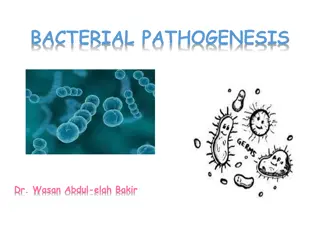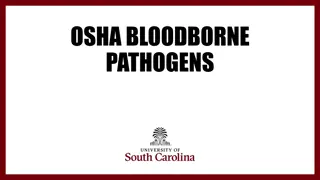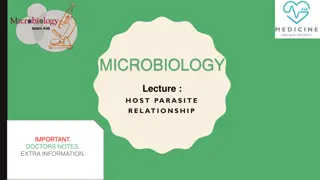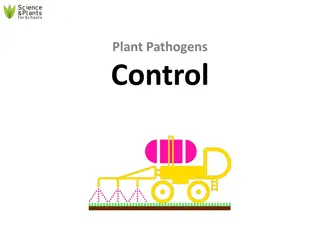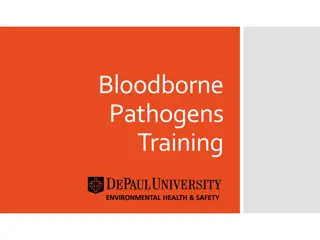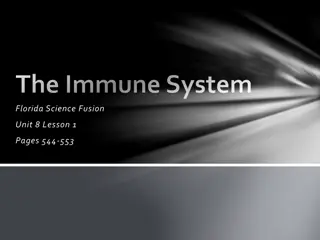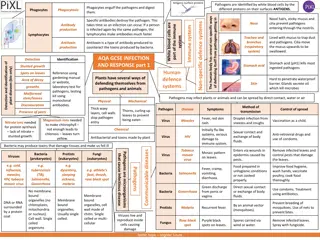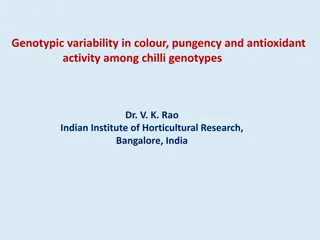
Variability in Pathogens and Mechanisms of Genetic Variability
Explore the concept of variability in pathogens, genetic mechanisms, and the emergence of new genes in response to resistance. Discover how genetic variability occurs in organisms such as fungi and the impact of asexual reproduction on variability. Gain insights into gene flow among plant pathogens.
Download Presentation

Please find below an Image/Link to download the presentation.
The content on the website is provided AS IS for your information and personal use only. It may not be sold, licensed, or shared on other websites without obtaining consent from the author. If you encounter any issues during the download, it is possible that the publisher has removed the file from their server.
You are allowed to download the files provided on this website for personal or commercial use, subject to the condition that they are used lawfully. All files are the property of their respective owners.
The content on the website is provided AS IS for your information and personal use only. It may not be sold, licensed, or shared on other websites without obtaining consent from the author.
E N D
Presentation Transcript
VARIABILITY IN PATHOGEN Dr. Rohini Trivedi Dept. of Botany MLSU
MECHANISMS OF VARIABILITY It has been the experience of researchers with numerous host pathogen however, that, after a new gene for resistance to a pathogen is introduced into a crop variety and that the variety is planted in the fields, a new population (race) of the pathogen appears that contains a new gene for virulence that enables the pathogen to attack the crop plants containing the new gene for resistance. combinations,
New genes can arise randomly and suddenly de novo through mutations, rearrangement of the genetic material of through the events of genetic variability in organisms. or by the ever pathogens ongoing
Genetic variability in true oomycetes and in fungi is produced from sexual spores such as oospores, ascospores, and basidiospores. In parasitic higher plants it is produced from seeds and produced from fertilized eggs. in nematodes is
When individuals are produced asexually, the frequency and degree of variability among the progeny are reduced greatly, but even then certain individuals among the progeny will characteristics. show different
Because number of by microorganisms asexually, the total amount produced by microorganisms is probably as great and possibly greater than the total variability found in microorganisms sexually. of the astronomical individuals produced of variability least at some reproducing
This overwhelmingly reproduction of fungi by means of conidia, zoospores, sclerotia, and uredospores. In bacteria, mollicutes, viruses. is the case in asexual the and
Gene and Genotype Flow among Plant Pathogens Gene flow is the process by which certain alleles (genes) population to another geographically separated population. In plant pathology, gene flow is very important because it deals with the movement of virulent mutant alleles among different field populations. move from one
High gene flow in a pathogen increases the size of the population and of the geographical area in which its genetic material occurs. Therefore, pathogens that show a high level of gene flow generally have greater genetic diversity than pathogens that show a low level of gene flow.
In pathogens reproducing only asexually, in recombination genotypes can be transferred from one population to another. This is known as genotype flow. which occurs, no entire
Pathogens spores or other propagules, such as rust and powdery mildew fungi, that can spread over long distances, can distribute their genomes over large areas, encompassing entire continents. that produce hardy sometimes
However, soil-borne fungi and nematodes slowly and are present in small areas and their level of genetic flow is limited. move
It is obvious that it is more likely that the one mutant of the smaller population will be lost than the 1,000 mutants of the larger population, i.e., in small populations, genetic drift results in a loss of alleles over time. In plant pathology, pathogens that exist in large populations have a greater potential for evolution than pathogens that exist in small populations.
Selection is a directional process by which the fittest variants in a particular environment increase their frequency in the population (positive selection), whereas less fit variants decrease. Selection results in a decrease in the diversity within a population, but it may cause an increase in the diversity between populations. Selection is affected by almost every factor- their frequency (negative selection), cycle of a pathogen, to its host, its vector if any and to the environment. the life
The kind of life cycle and the mating system followed affect the opportunities and limitations for genetic diversity (gene or and evolution of each particular pathogen. As a brief example we will mention the wheat stem rust fungus Puccinia graminis f. sp. tritici, which in the haploid state infects barberry while in the diploid state it infects wheat. Reproduction can be sexual, asexual, or both. In asexual pathogen populations, genotype diversity is more significant than gene diversity, whereas sexual pathogen populations show more gene diversity. genome diversity)
Therefore, pathogens undergoing any type of recombination greater threat than pathogens that undergo little or no recombination. The result of recombining pathogen can put together new combinations of virulence genes or alleles as fast as breeders can put together genes for resistance. pose a this is that population the
Therefore, pyramiding resistance genes in plants may not be as effective a strategy for as long as plant breeders hoped it would.
Specialized Mechanisms of Variability in Pathogens Sexual-like Processes in Fungi Heterokaryosis is the condition in which, as a result of fertilization or anastomosis, cells of fungal hyphae or parts of hyphae contain two or more nuclei that are genetically different.
Parasexualism is the process by which genetic recombinations can occur within fungal heterokaryons. This comes about by the occasional fusion of the formation of a diploid nucleus. two nuclei and
During multiplication, crossing-over occurs in a few mitotic divisions and results in the appearance of genetic recombinants as the diploid nucleus progressively and individual chromosomes to revert to its haploid state. rapidly loses
Heteroploidy is the existence of cells, tissues, or whole organisms with numbers of chromosomes per nucleus. Heteroploids haploids, diploids, tetraploids or aneuploids may be triploids, they or be may
Aneuploids, i.e., have one, two, three, or chromosomes or are missing one or more chromosomes from the normal euploid number more extra
New biotypes of bacteria seem to arise with varying frequency by means of at least three sexual-like processes TRANSFORMATION CONJUGATION and TRANSDUCTION. ,
Genetic Recombination in Viruses When two strains of the same virus are inoculated into plant, one or more new virus strains are recovered (virulence, symptomatology)different from those of either of the original strains introduced into the host. the same host with properties
Loss of Pathogen Virulence in Culture The microorganisms toward one or all of their hosts often decreases when the pathogens are kept in culture for relatively long periods of time or when they are passed one or more times through different hosts. virulence of pathogenic
The new strains probably are recombinants, although their appearance through mutation cannot be ruled out.
If the culturing of the pathogen is prolonged sufficiently, the pathogen may lose virulence completely. Such partial or complete loss of virulence in pathogens is sometimes called attenuation, and it has been shown to occur in bacteria, fungi, and viruses.
Refer to chapter 4 of Agrios. (the e-book has already been forwarded to you via your email IDs ) Happy learning Stay Home stay safe healthy and study

